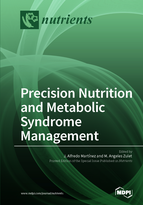Precision Nutrition and Metabolic Syndrome Management
A special issue of Nutrients (ISSN 2072-6643).
Deadline for manuscript submissions: closed (31 July 2017) | Viewed by 171846
Special Issue Editors
Interests: nutritional control of metabolism; the nutritional utilization of functional foods; the evaluation of nutritional status in different populations; nutrition and inflammation; and cell, animal and human .experimental. interventional and epidemiological studies in obesity
Special Issues, Collections and Topics in MDPI journals
Centro de Investigación Biomédica en Red de la Fisiopatología de la Obesidad y Nutrición (CIBERobn), Instituto de Salud Carlos III, 28029 Madrid, Spain
Navarra Institute for Health Research (IdiSNA), 31008 Pamplona, Spain
Interests: non-alcoholic fatty liver disease; metabolic syndrome; obesity; insulin resistance; cardiovascular disease; body composition; dietary patterns; precision nutrition; personalized nutrition; lifestyle intervention
Special Issues, Collections and Topics in MDPI journals
Special Issue Information
Dear Colleagues,
Precision nutrition is an emerging concept encompassing an integrated action considering, not only the genetic/epigenetic make-up and ethnic aspects of individuals, but other personalized phenotypical features, such as family and individual clinical issues, previous diseases, and therapeutic treatments, perinatal nutrition, food likes/dislikes, allergies/intolerances, lifestyle attitudes and patterns, social and cultural circumstances or religious beliefs, etc.
In this context, chronic disease prevalence is a global public health problem itself, which is also accompanied by a number of complications, including insulin resistance, hypertension, hypercholesterolemia, fatty liver, inflammatory, oxidative status and inmunocompetence disturbances, and other adverse manifestations related to metabolic syndrome, which may need individualized nutritional approaches.
Therefore, the current special issue attempts to provide specific nutritional strategies to prevent or treat complications associated to metabolic syndrome features concerning diabetes, vascular events, liver diseases, dyslipemia, and cancer with a precision nutrition scope.
Prof. Dr. J. Alfredo Martínez
Prof. M. Angeles Zulet
Guest Editors
Manuscript Submission Information
Manuscripts should be submitted online at www.mdpi.com by registering and logging in to this website. Once you are registered, click here to go to the submission form. Manuscripts can be submitted until the deadline. All submissions that pass pre-check are peer-reviewed. Accepted papers will be published continuously in the journal (as soon as accepted) and will be listed together on the special issue website. Research articles, review articles as well as short communications are invited. For planned papers, a title and short abstract (about 100 words) can be sent to the Editorial Office for announcement on this website.
Submitted manuscripts should not have been published previously, nor be under consideration for publication elsewhere (except conference proceedings papers). All manuscripts are thoroughly refereed through a single-blind peer-review process. A guide for authors and other relevant information for submission of manuscripts is available on the Instructions for Authors page. Nutrients is an international peer-reviewed open access semimonthly journal published by MDPI.
Please visit the Instructions for Authors page before submitting a manuscript. The Article Processing Charge (APC) for publication in this open access journal is 2900 CHF (Swiss Francs). Submitted papers should be well formatted and use good English. Authors may use MDPI's English editing service prior to publication or during author revisions.
Keywords
- NAFLD
- Hypertension
- Inflammation
- Oxidative stress
- Microbiota
- Dietary patterns
- Nutritional intervention
- Precision nutrition
- Personalization
- Chrononutrition
- Nutrigenetics/Nutrigenomics







